Health Studies 300: Health in Canada - Pipeline Impact Analysis
VerifiedAdded on 2022/09/07
|14
|3873
|25
Report
AI Summary
This report provides a critical analysis of the Trans Mountain pipeline project in Canada, examining its health impacts on both the environment and local communities. It begins with an overview of the pipeline, its benefits such as job creation, revenue generation, and increased pipeline capacity, and its potential to improve transportation for indigenous farmers. The report then delves into the drawbacks, focusing on environmental and health concerns. These include the contamination of traditional food sources, potential impacts on agriculture, increased risks of oil spills, and the effects on indigenous communities. The report also highlights the impact on water sources and marine life, and the potential for increased greenhouse gas emissions. The conclusion emphasizes the need to balance economic benefits with environmental and health considerations. This report aims to provide a comprehensive understanding of the complex issues surrounding the Trans Mountain pipeline project.
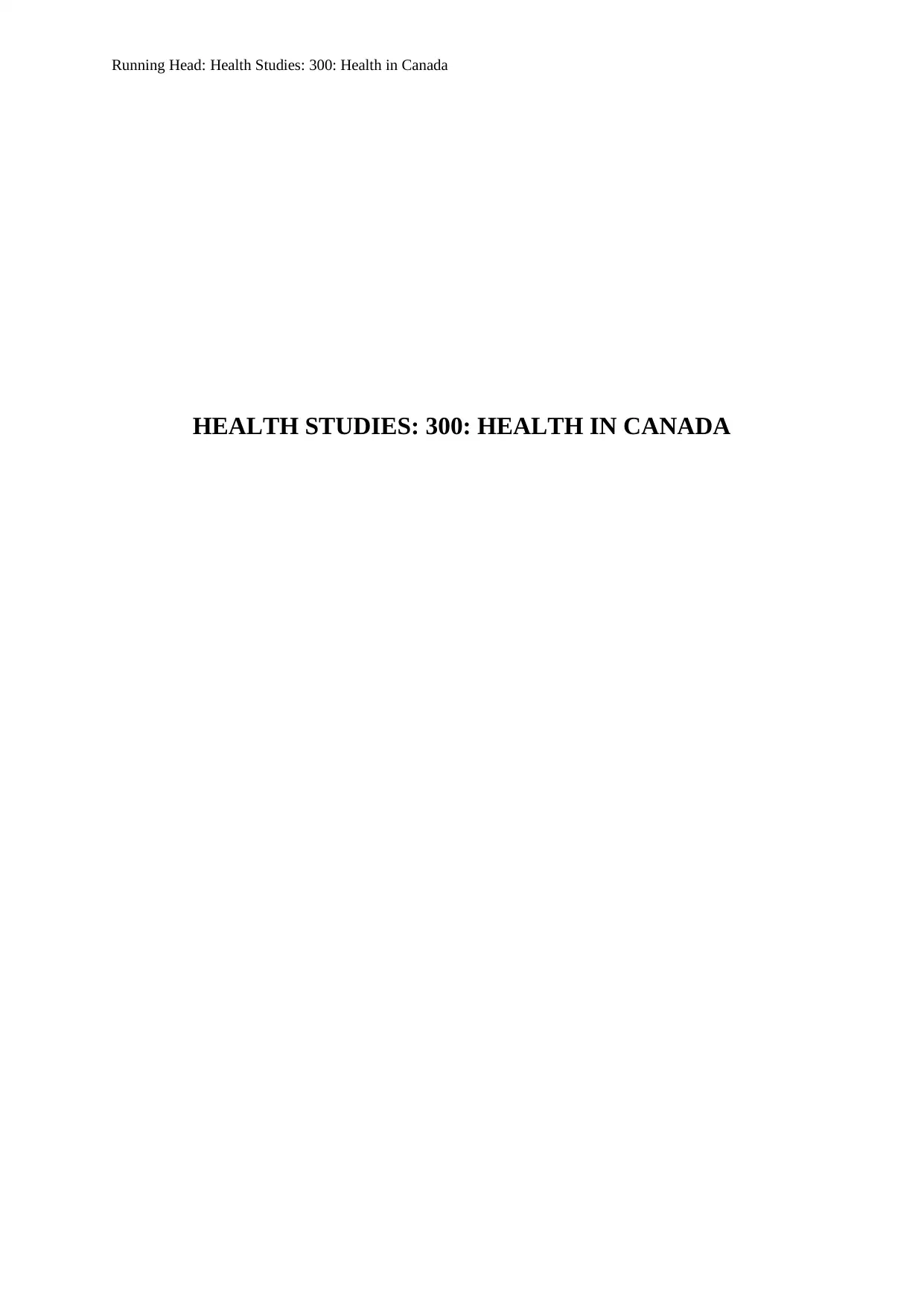
Running Head: Health Studies: 300: Health in Canada
HEALTH STUDIES: 300: HEALTH IN CANADA
HEALTH STUDIES: 300: HEALTH IN CANADA
Paraphrase This Document
Need a fresh take? Get an instant paraphrase of this document with our AI Paraphraser
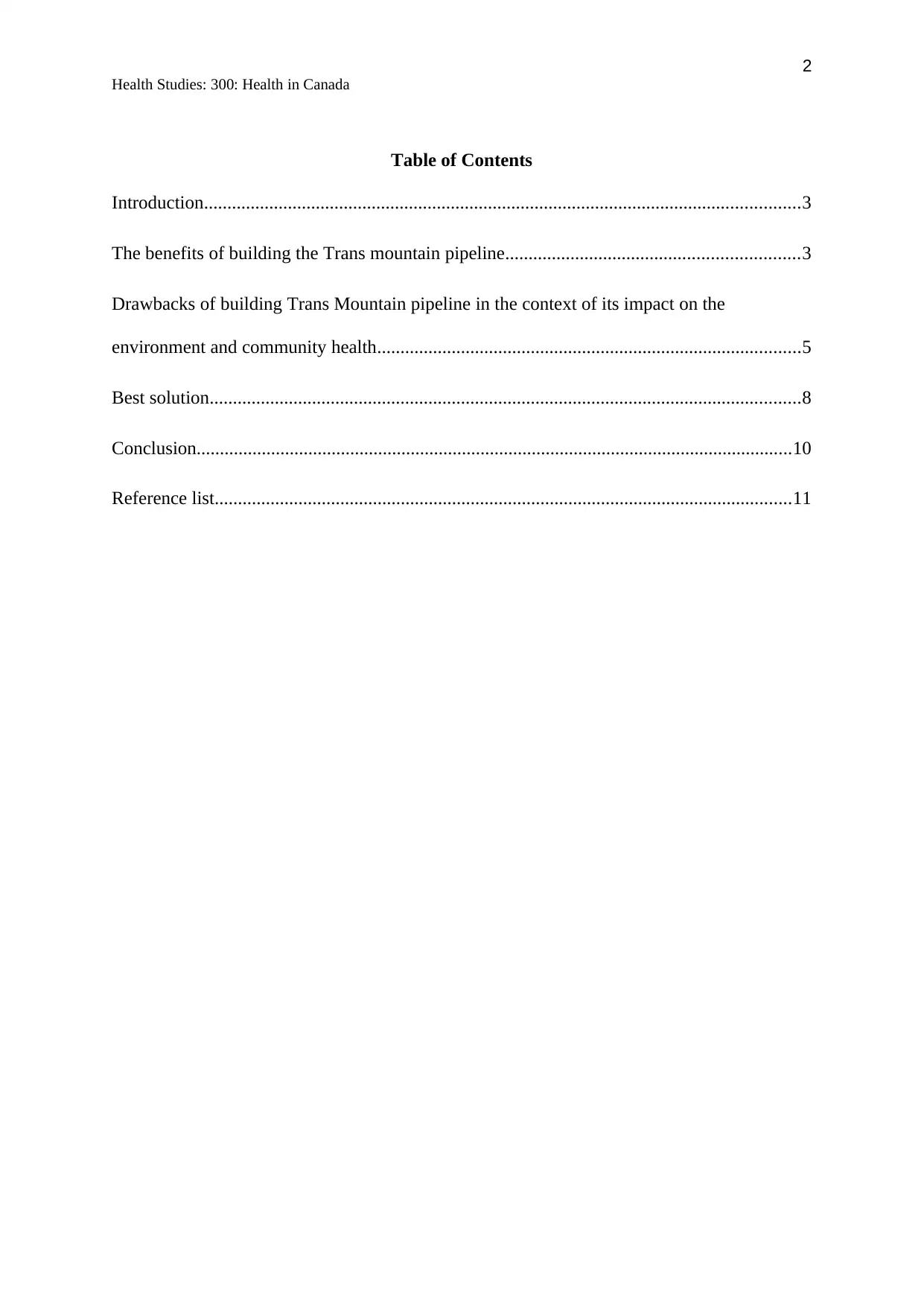
2
Health Studies: 300: Health in Canada
Table of Contents
Introduction................................................................................................................................3
The benefits of building the Trans mountain pipeline...............................................................3
Drawbacks of building Trans Mountain pipeline in the context of its impact on the
environment and community health...........................................................................................5
Best solution...............................................................................................................................8
Conclusion................................................................................................................................10
Reference list............................................................................................................................11
Health Studies: 300: Health in Canada
Table of Contents
Introduction................................................................................................................................3
The benefits of building the Trans mountain pipeline...............................................................3
Drawbacks of building Trans Mountain pipeline in the context of its impact on the
environment and community health...........................................................................................5
Best solution...............................................................................................................................8
Conclusion................................................................................................................................10
Reference list............................................................................................................................11
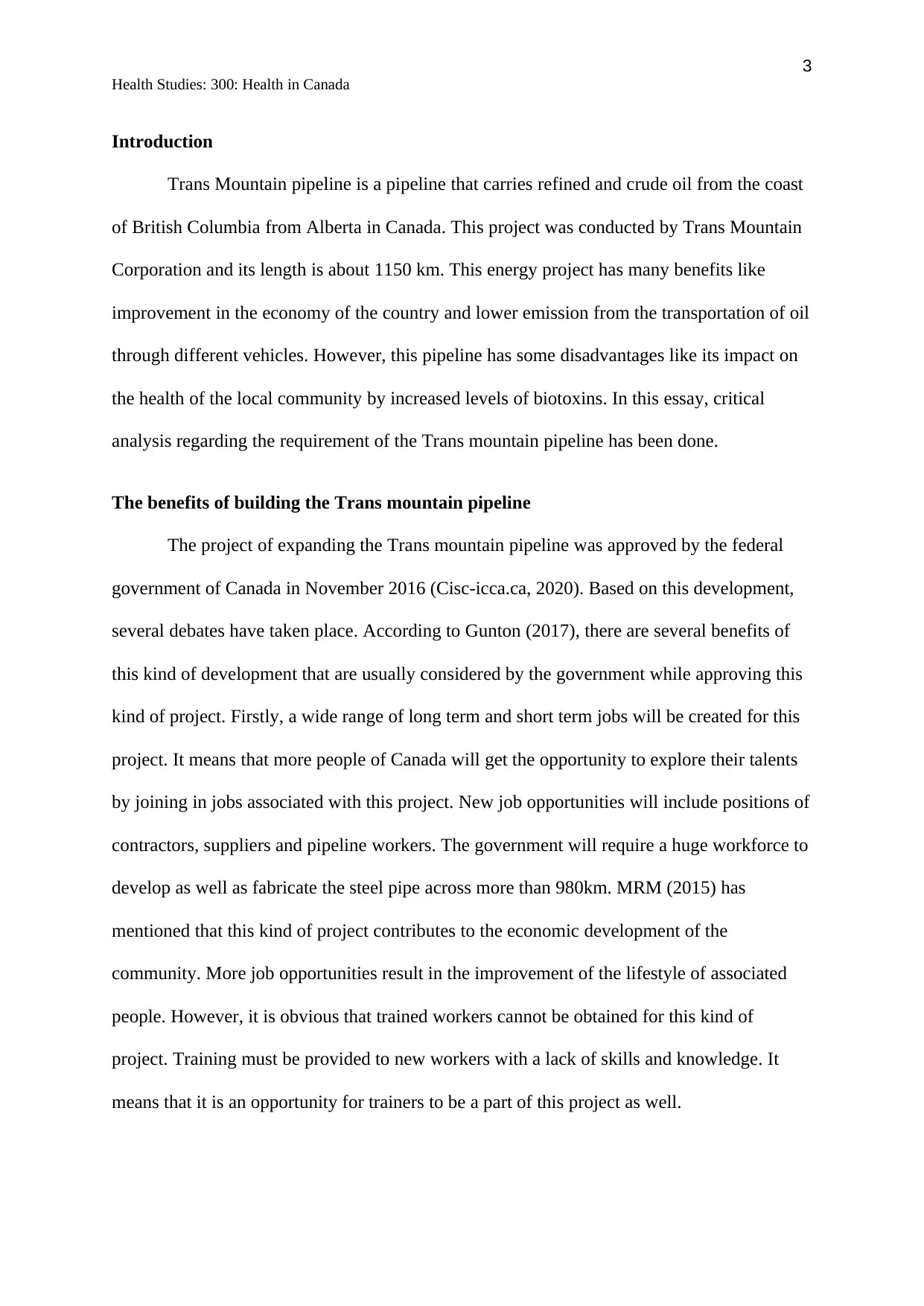
3
Health Studies: 300: Health in Canada
Introduction
Trans Mountain pipeline is a pipeline that carries refined and crude oil from the coast
of British Columbia from Alberta in Canada. This project was conducted by Trans Mountain
Corporation and its length is about 1150 km. This energy project has many benefits like
improvement in the economy of the country and lower emission from the transportation of oil
through different vehicles. However, this pipeline has some disadvantages like its impact on
the health of the local community by increased levels of biotoxins. In this essay, critical
analysis regarding the requirement of the Trans mountain pipeline has been done.
The benefits of building the Trans mountain pipeline
The project of expanding the Trans mountain pipeline was approved by the federal
government of Canada in November 2016 (Cisc-icca.ca, 2020). Based on this development,
several debates have taken place. According to Gunton (2017), there are several benefits of
this kind of development that are usually considered by the government while approving this
kind of project. Firstly, a wide range of long term and short term jobs will be created for this
project. It means that more people of Canada will get the opportunity to explore their talents
by joining in jobs associated with this project. New job opportunities will include positions of
contractors, suppliers and pipeline workers. The government will require a huge workforce to
develop as well as fabricate the steel pipe across more than 980km. MRM (2015) has
mentioned that this kind of project contributes to the economic development of the
community. More job opportunities result in the improvement of the lifestyle of associated
people. However, it is obvious that trained workers cannot be obtained for this kind of
project. Training must be provided to new workers with a lack of skills and knowledge. It
means that it is an opportunity for trainers to be a part of this project as well.
Health Studies: 300: Health in Canada
Introduction
Trans Mountain pipeline is a pipeline that carries refined and crude oil from the coast
of British Columbia from Alberta in Canada. This project was conducted by Trans Mountain
Corporation and its length is about 1150 km. This energy project has many benefits like
improvement in the economy of the country and lower emission from the transportation of oil
through different vehicles. However, this pipeline has some disadvantages like its impact on
the health of the local community by increased levels of biotoxins. In this essay, critical
analysis regarding the requirement of the Trans mountain pipeline has been done.
The benefits of building the Trans mountain pipeline
The project of expanding the Trans mountain pipeline was approved by the federal
government of Canada in November 2016 (Cisc-icca.ca, 2020). Based on this development,
several debates have taken place. According to Gunton (2017), there are several benefits of
this kind of development that are usually considered by the government while approving this
kind of project. Firstly, a wide range of long term and short term jobs will be created for this
project. It means that more people of Canada will get the opportunity to explore their talents
by joining in jobs associated with this project. New job opportunities will include positions of
contractors, suppliers and pipeline workers. The government will require a huge workforce to
develop as well as fabricate the steel pipe across more than 980km. MRM (2015) has
mentioned that this kind of project contributes to the economic development of the
community. More job opportunities result in the improvement of the lifestyle of associated
people. However, it is obvious that trained workers cannot be obtained for this kind of
project. Training must be provided to new workers with a lack of skills and knowledge. It
means that it is an opportunity for trainers to be a part of this project as well.
⊘ This is a preview!⊘
Do you want full access?
Subscribe today to unlock all pages.

Trusted by 1+ million students worldwide
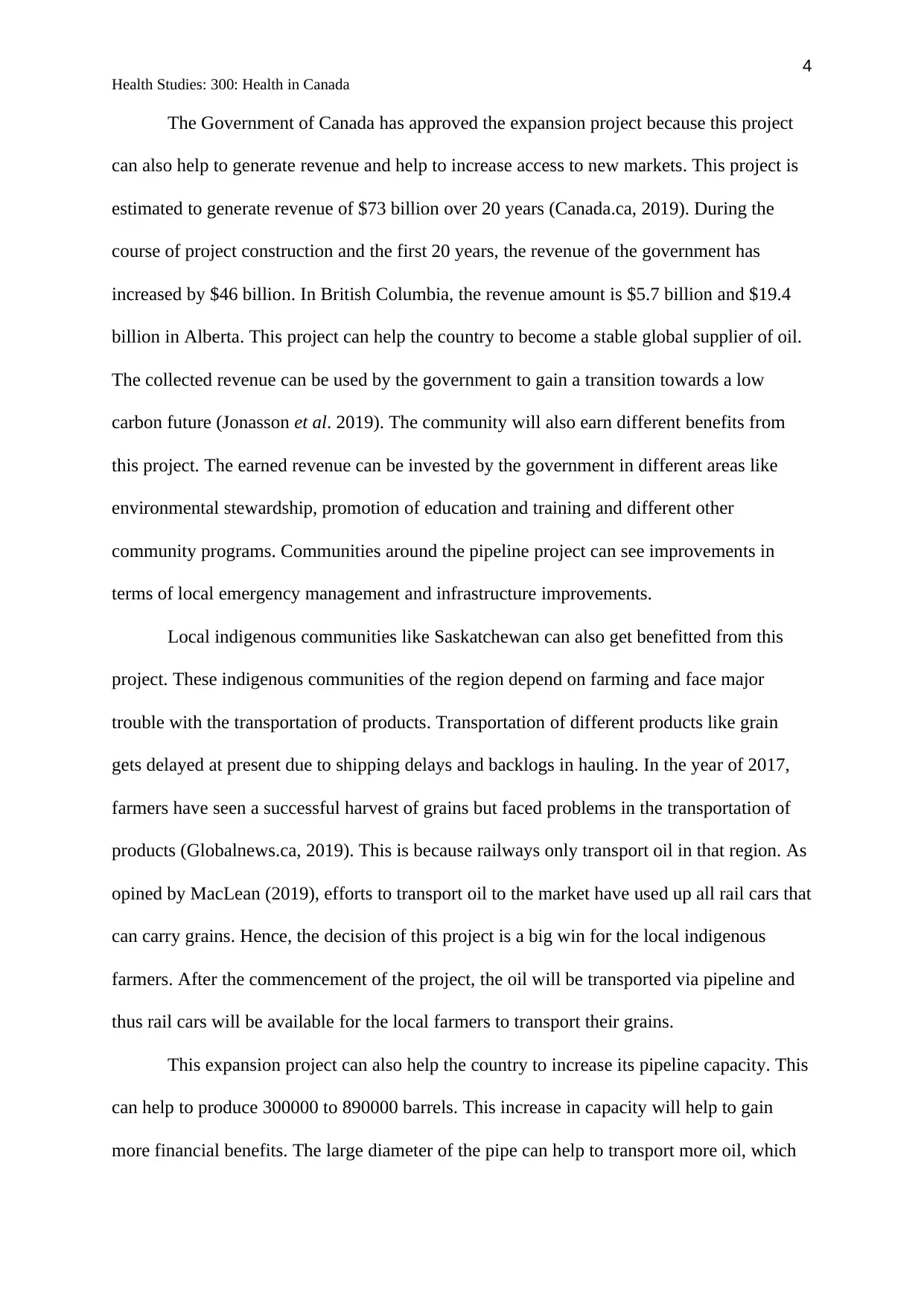
4
Health Studies: 300: Health in Canada
The Government of Canada has approved the expansion project because this project
can also help to generate revenue and help to increase access to new markets. This project is
estimated to generate revenue of $73 billion over 20 years (Canada.ca, 2019). During the
course of project construction and the first 20 years, the revenue of the government has
increased by $46 billion. In British Columbia, the revenue amount is $5.7 billion and $19.4
billion in Alberta. This project can help the country to become a stable global supplier of oil.
The collected revenue can be used by the government to gain a transition towards a low
carbon future (Jonasson et al. 2019). The community will also earn different benefits from
this project. The earned revenue can be invested by the government in different areas like
environmental stewardship, promotion of education and training and different other
community programs. Communities around the pipeline project can see improvements in
terms of local emergency management and infrastructure improvements.
Local indigenous communities like Saskatchewan can also get benefitted from this
project. These indigenous communities of the region depend on farming and face major
trouble with the transportation of products. Transportation of different products like grain
gets delayed at present due to shipping delays and backlogs in hauling. In the year of 2017,
farmers have seen a successful harvest of grains but faced problems in the transportation of
products (Globalnews.ca, 2019). This is because railways only transport oil in that region. As
opined by MacLean (2019), efforts to transport oil to the market have used up all rail cars that
can carry grains. Hence, the decision of this project is a big win for the local indigenous
farmers. After the commencement of the project, the oil will be transported via pipeline and
thus rail cars will be available for the local farmers to transport their grains.
This expansion project can also help the country to increase its pipeline capacity. This
can help to produce 300000 to 890000 barrels. This increase in capacity will help to gain
more financial benefits. The large diameter of the pipe can help to transport more oil, which
Health Studies: 300: Health in Canada
The Government of Canada has approved the expansion project because this project
can also help to generate revenue and help to increase access to new markets. This project is
estimated to generate revenue of $73 billion over 20 years (Canada.ca, 2019). During the
course of project construction and the first 20 years, the revenue of the government has
increased by $46 billion. In British Columbia, the revenue amount is $5.7 billion and $19.4
billion in Alberta. This project can help the country to become a stable global supplier of oil.
The collected revenue can be used by the government to gain a transition towards a low
carbon future (Jonasson et al. 2019). The community will also earn different benefits from
this project. The earned revenue can be invested by the government in different areas like
environmental stewardship, promotion of education and training and different other
community programs. Communities around the pipeline project can see improvements in
terms of local emergency management and infrastructure improvements.
Local indigenous communities like Saskatchewan can also get benefitted from this
project. These indigenous communities of the region depend on farming and face major
trouble with the transportation of products. Transportation of different products like grain
gets delayed at present due to shipping delays and backlogs in hauling. In the year of 2017,
farmers have seen a successful harvest of grains but faced problems in the transportation of
products (Globalnews.ca, 2019). This is because railways only transport oil in that region. As
opined by MacLean (2019), efforts to transport oil to the market have used up all rail cars that
can carry grains. Hence, the decision of this project is a big win for the local indigenous
farmers. After the commencement of the project, the oil will be transported via pipeline and
thus rail cars will be available for the local farmers to transport their grains.
This expansion project can also help the country to increase its pipeline capacity. This
can help to produce 300000 to 890000 barrels. This increase in capacity will help to gain
more financial benefits. The large diameter of the pipe can help to transport more oil, which
Paraphrase This Document
Need a fresh take? Get an instant paraphrase of this document with our AI Paraphraser
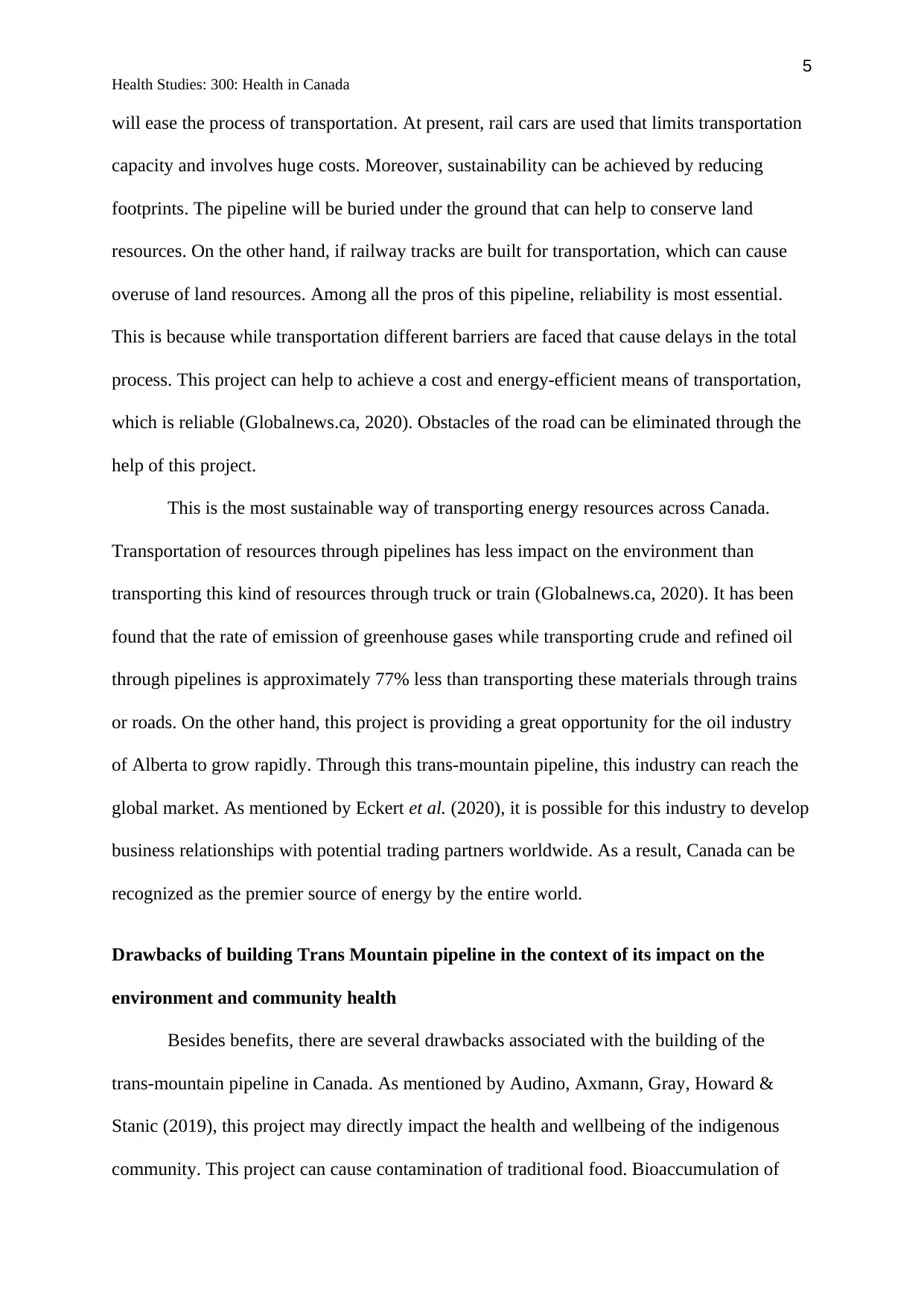
5
Health Studies: 300: Health in Canada
will ease the process of transportation. At present, rail cars are used that limits transportation
capacity and involves huge costs. Moreover, sustainability can be achieved by reducing
footprints. The pipeline will be buried under the ground that can help to conserve land
resources. On the other hand, if railway tracks are built for transportation, which can cause
overuse of land resources. Among all the pros of this pipeline, reliability is most essential.
This is because while transportation different barriers are faced that cause delays in the total
process. This project can help to achieve a cost and energy-efficient means of transportation,
which is reliable (Globalnews.ca, 2020). Obstacles of the road can be eliminated through the
help of this project.
This is the most sustainable way of transporting energy resources across Canada.
Transportation of resources through pipelines has less impact on the environment than
transporting this kind of resources through truck or train (Globalnews.ca, 2020). It has been
found that the rate of emission of greenhouse gases while transporting crude and refined oil
through pipelines is approximately 77% less than transporting these materials through trains
or roads. On the other hand, this project is providing a great opportunity for the oil industry
of Alberta to grow rapidly. Through this trans-mountain pipeline, this industry can reach the
global market. As mentioned by Eckert et al. (2020), it is possible for this industry to develop
business relationships with potential trading partners worldwide. As a result, Canada can be
recognized as the premier source of energy by the entire world.
Drawbacks of building Trans Mountain pipeline in the context of its impact on the
environment and community health
Besides benefits, there are several drawbacks associated with the building of the
trans-mountain pipeline in Canada. As mentioned by Audino, Axmann, Gray, Howard &
Stanic (2019), this project may directly impact the health and wellbeing of the indigenous
community. This project can cause contamination of traditional food. Bioaccumulation of
Health Studies: 300: Health in Canada
will ease the process of transportation. At present, rail cars are used that limits transportation
capacity and involves huge costs. Moreover, sustainability can be achieved by reducing
footprints. The pipeline will be buried under the ground that can help to conserve land
resources. On the other hand, if railway tracks are built for transportation, which can cause
overuse of land resources. Among all the pros of this pipeline, reliability is most essential.
This is because while transportation different barriers are faced that cause delays in the total
process. This project can help to achieve a cost and energy-efficient means of transportation,
which is reliable (Globalnews.ca, 2020). Obstacles of the road can be eliminated through the
help of this project.
This is the most sustainable way of transporting energy resources across Canada.
Transportation of resources through pipelines has less impact on the environment than
transporting this kind of resources through truck or train (Globalnews.ca, 2020). It has been
found that the rate of emission of greenhouse gases while transporting crude and refined oil
through pipelines is approximately 77% less than transporting these materials through trains
or roads. On the other hand, this project is providing a great opportunity for the oil industry
of Alberta to grow rapidly. Through this trans-mountain pipeline, this industry can reach the
global market. As mentioned by Eckert et al. (2020), it is possible for this industry to develop
business relationships with potential trading partners worldwide. As a result, Canada can be
recognized as the premier source of energy by the entire world.
Drawbacks of building Trans Mountain pipeline in the context of its impact on the
environment and community health
Besides benefits, there are several drawbacks associated with the building of the
trans-mountain pipeline in Canada. As mentioned by Audino, Axmann, Gray, Howard &
Stanic (2019), this project may directly impact the health and wellbeing of the indigenous
community. This project can cause contamination of traditional food. Bioaccumulation of
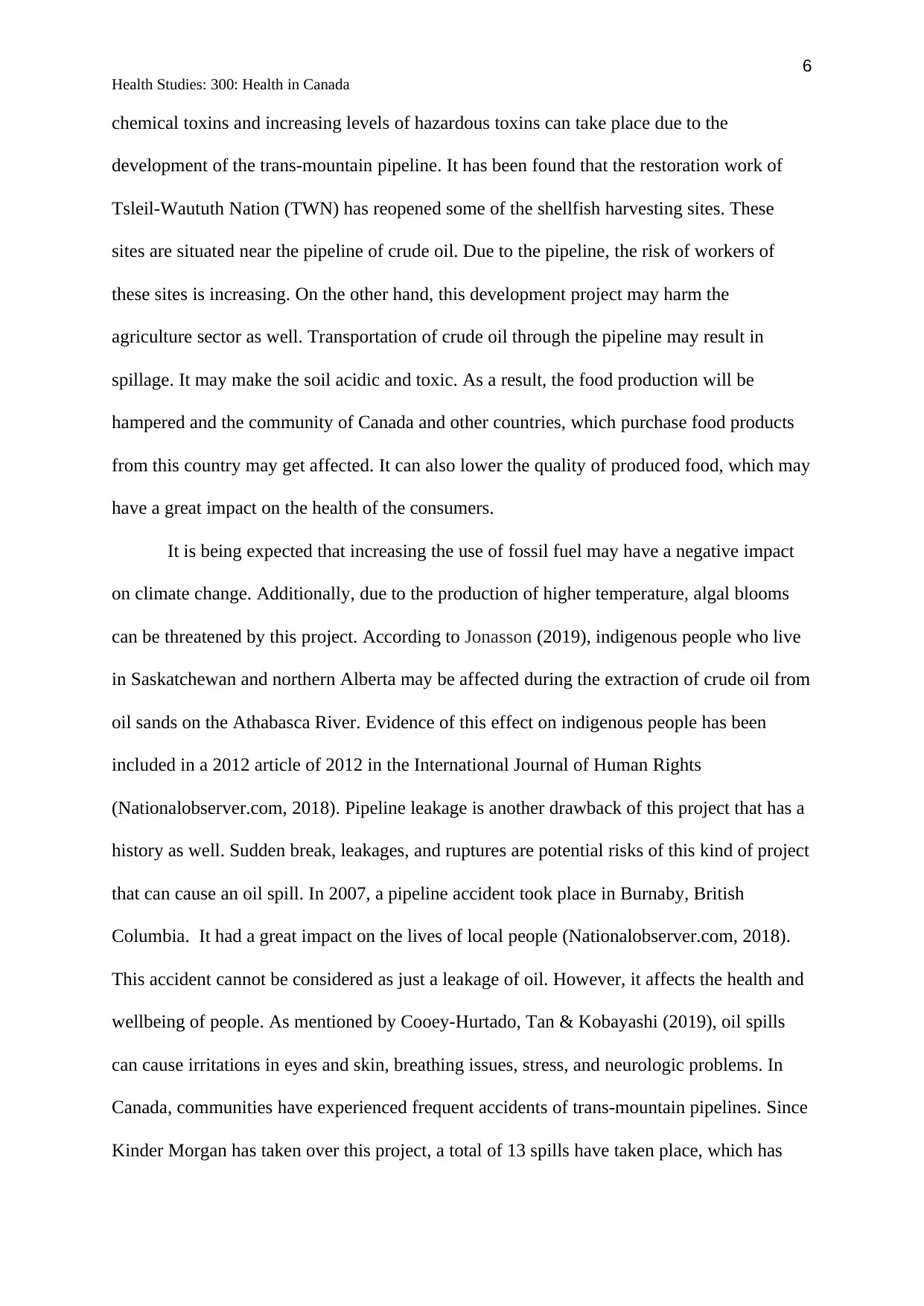
6
Health Studies: 300: Health in Canada
chemical toxins and increasing levels of hazardous toxins can take place due to the
development of the trans-mountain pipeline. It has been found that the restoration work of
Tsleil-Waututh Nation (TWN) has reopened some of the shellfish harvesting sites. These
sites are situated near the pipeline of crude oil. Due to the pipeline, the risk of workers of
these sites is increasing. On the other hand, this development project may harm the
agriculture sector as well. Transportation of crude oil through the pipeline may result in
spillage. It may make the soil acidic and toxic. As a result, the food production will be
hampered and the community of Canada and other countries, which purchase food products
from this country may get affected. It can also lower the quality of produced food, which may
have a great impact on the health of the consumers.
It is being expected that increasing the use of fossil fuel may have a negative impact
on climate change. Additionally, due to the production of higher temperature, algal blooms
can be threatened by this project. According to Jonasson (2019), indigenous people who live
in Saskatchewan and northern Alberta may be affected during the extraction of crude oil from
oil sands on the Athabasca River. Evidence of this effect on indigenous people has been
included in a 2012 article of 2012 in the International Journal of Human Rights
(Nationalobserver.com, 2018). Pipeline leakage is another drawback of this project that has a
history as well. Sudden break, leakages, and ruptures are potential risks of this kind of project
that can cause an oil spill. In 2007, a pipeline accident took place in Burnaby, British
Columbia. It had a great impact on the lives of local people (Nationalobserver.com, 2018).
This accident cannot be considered as just a leakage of oil. However, it affects the health and
wellbeing of people. As mentioned by Cooey-Hurtado, Tan & Kobayashi (2019), oil spills
can cause irritations in eyes and skin, breathing issues, stress, and neurologic problems. In
Canada, communities have experienced frequent accidents of trans-mountain pipelines. Since
Kinder Morgan has taken over this project, a total of 13 spills have taken place, which has
Health Studies: 300: Health in Canada
chemical toxins and increasing levels of hazardous toxins can take place due to the
development of the trans-mountain pipeline. It has been found that the restoration work of
Tsleil-Waututh Nation (TWN) has reopened some of the shellfish harvesting sites. These
sites are situated near the pipeline of crude oil. Due to the pipeline, the risk of workers of
these sites is increasing. On the other hand, this development project may harm the
agriculture sector as well. Transportation of crude oil through the pipeline may result in
spillage. It may make the soil acidic and toxic. As a result, the food production will be
hampered and the community of Canada and other countries, which purchase food products
from this country may get affected. It can also lower the quality of produced food, which may
have a great impact on the health of the consumers.
It is being expected that increasing the use of fossil fuel may have a negative impact
on climate change. Additionally, due to the production of higher temperature, algal blooms
can be threatened by this project. According to Jonasson (2019), indigenous people who live
in Saskatchewan and northern Alberta may be affected during the extraction of crude oil from
oil sands on the Athabasca River. Evidence of this effect on indigenous people has been
included in a 2012 article of 2012 in the International Journal of Human Rights
(Nationalobserver.com, 2018). Pipeline leakage is another drawback of this project that has a
history as well. Sudden break, leakages, and ruptures are potential risks of this kind of project
that can cause an oil spill. In 2007, a pipeline accident took place in Burnaby, British
Columbia. It had a great impact on the lives of local people (Nationalobserver.com, 2018).
This accident cannot be considered as just a leakage of oil. However, it affects the health and
wellbeing of people. As mentioned by Cooey-Hurtado, Tan & Kobayashi (2019), oil spills
can cause irritations in eyes and skin, breathing issues, stress, and neurologic problems. In
Canada, communities have experienced frequent accidents of trans-mountain pipelines. Since
Kinder Morgan has taken over this project, a total of 13 spills have taken place, which has
⊘ This is a preview!⊘
Do you want full access?
Subscribe today to unlock all pages.

Trusted by 1+ million students worldwide
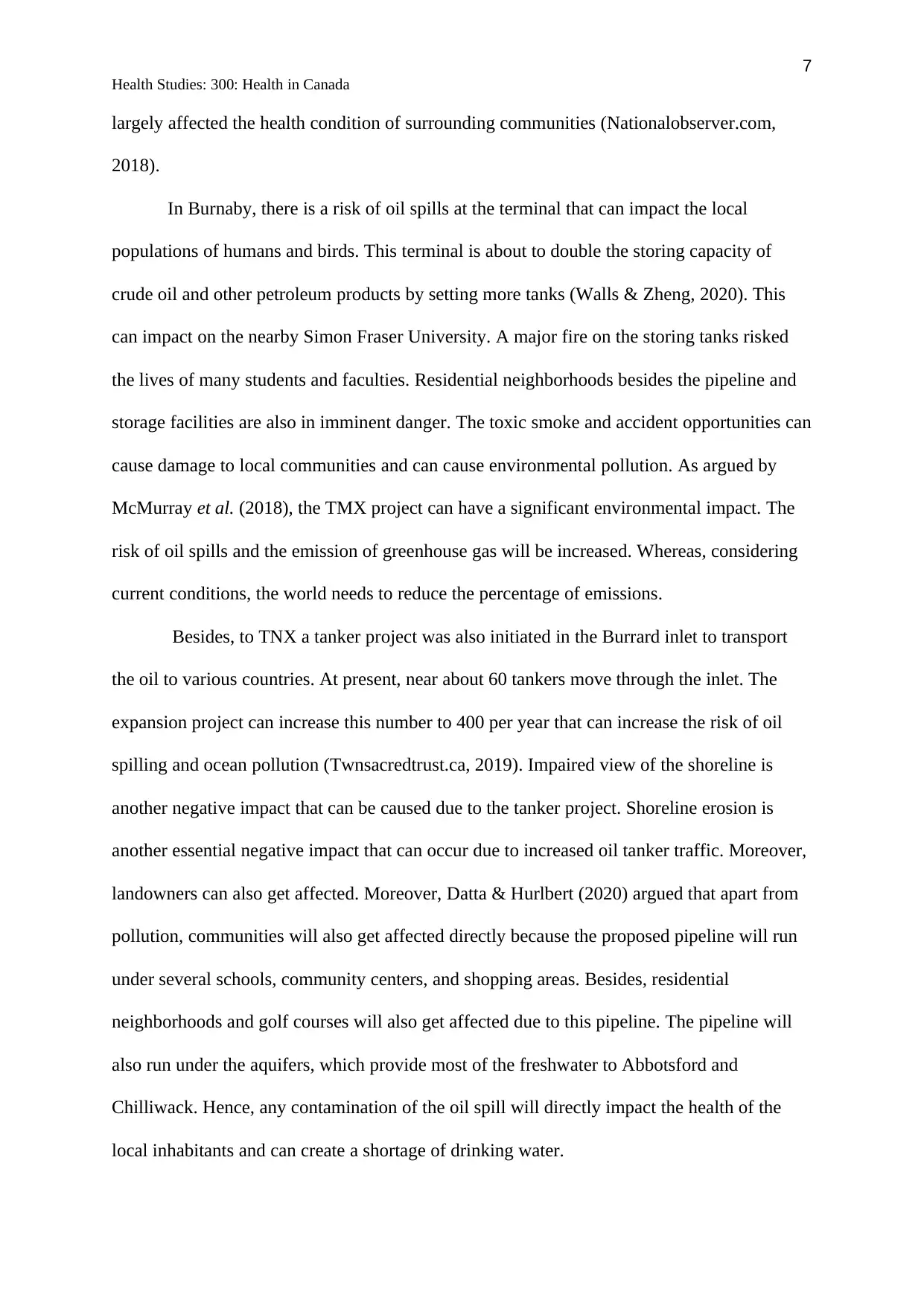
7
Health Studies: 300: Health in Canada
largely affected the health condition of surrounding communities (Nationalobserver.com,
2018).
In Burnaby, there is a risk of oil spills at the terminal that can impact the local
populations of humans and birds. This terminal is about to double the storing capacity of
crude oil and other petroleum products by setting more tanks (Walls & Zheng, 2020). This
can impact on the nearby Simon Fraser University. A major fire on the storing tanks risked
the lives of many students and faculties. Residential neighborhoods besides the pipeline and
storage facilities are also in imminent danger. The toxic smoke and accident opportunities can
cause damage to local communities and can cause environmental pollution. As argued by
McMurray et al. (2018), the TMX project can have a significant environmental impact. The
risk of oil spills and the emission of greenhouse gas will be increased. Whereas, considering
current conditions, the world needs to reduce the percentage of emissions.
Besides, to TNX a tanker project was also initiated in the Burrard inlet to transport
the oil to various countries. At present, near about 60 tankers move through the inlet. The
expansion project can increase this number to 400 per year that can increase the risk of oil
spilling and ocean pollution (Twnsacredtrust.ca, 2019). Impaired view of the shoreline is
another negative impact that can be caused due to the tanker project. Shoreline erosion is
another essential negative impact that can occur due to increased oil tanker traffic. Moreover,
landowners can also get affected. Moreover, Datta & Hurlbert (2020) argued that apart from
pollution, communities will also get affected directly because the proposed pipeline will run
under several schools, community centers, and shopping areas. Besides, residential
neighborhoods and golf courses will also get affected due to this pipeline. The pipeline will
also run under the aquifers, which provide most of the freshwater to Abbotsford and
Chilliwack. Hence, any contamination of the oil spill will directly impact the health of the
local inhabitants and can create a shortage of drinking water.
Health Studies: 300: Health in Canada
largely affected the health condition of surrounding communities (Nationalobserver.com,
2018).
In Burnaby, there is a risk of oil spills at the terminal that can impact the local
populations of humans and birds. This terminal is about to double the storing capacity of
crude oil and other petroleum products by setting more tanks (Walls & Zheng, 2020). This
can impact on the nearby Simon Fraser University. A major fire on the storing tanks risked
the lives of many students and faculties. Residential neighborhoods besides the pipeline and
storage facilities are also in imminent danger. The toxic smoke and accident opportunities can
cause damage to local communities and can cause environmental pollution. As argued by
McMurray et al. (2018), the TMX project can have a significant environmental impact. The
risk of oil spills and the emission of greenhouse gas will be increased. Whereas, considering
current conditions, the world needs to reduce the percentage of emissions.
Besides, to TNX a tanker project was also initiated in the Burrard inlet to transport
the oil to various countries. At present, near about 60 tankers move through the inlet. The
expansion project can increase this number to 400 per year that can increase the risk of oil
spilling and ocean pollution (Twnsacredtrust.ca, 2019). Impaired view of the shoreline is
another negative impact that can be caused due to the tanker project. Shoreline erosion is
another essential negative impact that can occur due to increased oil tanker traffic. Moreover,
landowners can also get affected. Moreover, Datta & Hurlbert (2020) argued that apart from
pollution, communities will also get affected directly because the proposed pipeline will run
under several schools, community centers, and shopping areas. Besides, residential
neighborhoods and golf courses will also get affected due to this pipeline. The pipeline will
also run under the aquifers, which provide most of the freshwater to Abbotsford and
Chilliwack. Hence, any contamination of the oil spill will directly impact the health of the
local inhabitants and can create a shortage of drinking water.
Paraphrase This Document
Need a fresh take? Get an instant paraphrase of this document with our AI Paraphraser
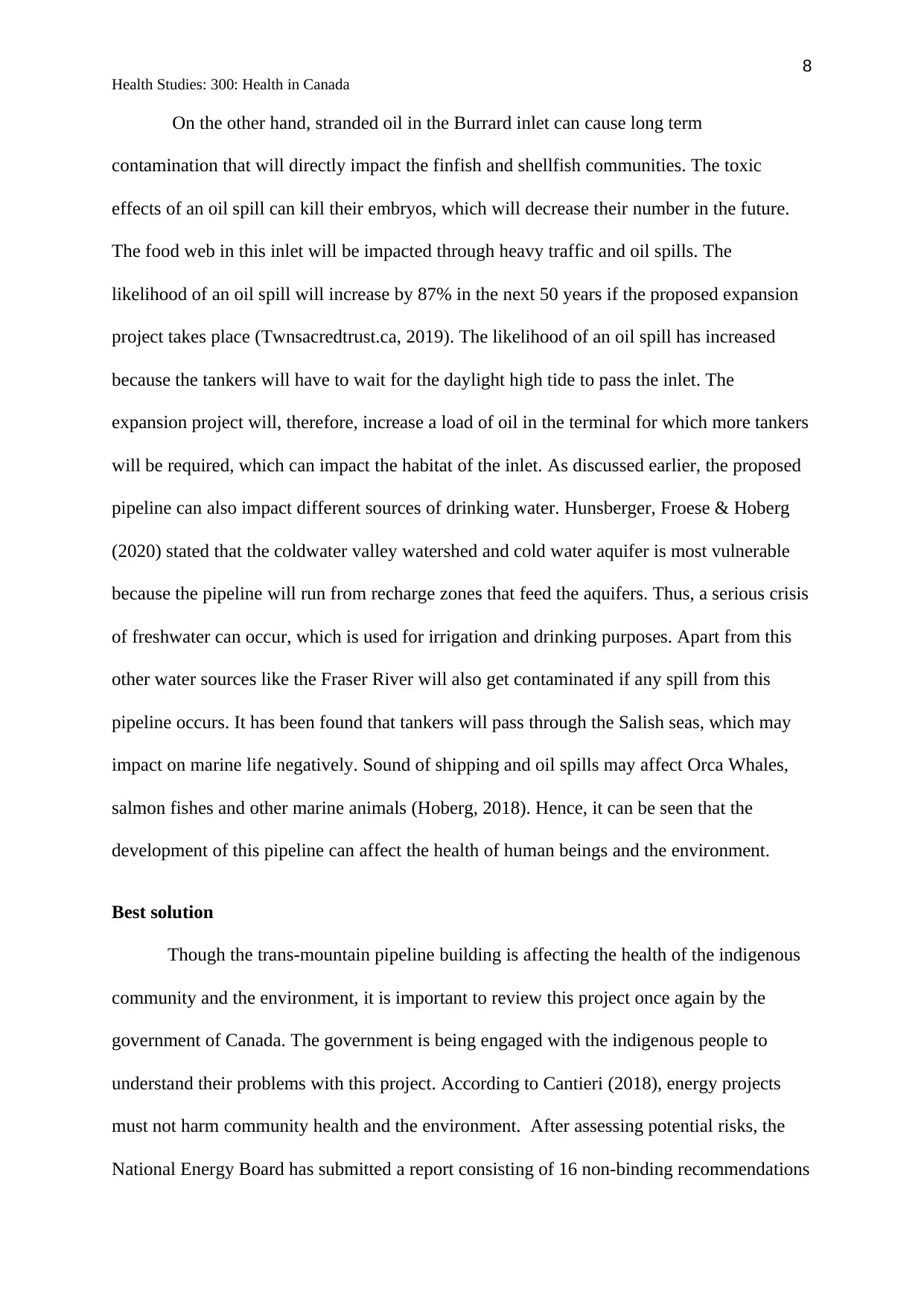
8
Health Studies: 300: Health in Canada
On the other hand, stranded oil in the Burrard inlet can cause long term
contamination that will directly impact the finfish and shellfish communities. The toxic
effects of an oil spill can kill their embryos, which will decrease their number in the future.
The food web in this inlet will be impacted through heavy traffic and oil spills. The
likelihood of an oil spill will increase by 87% in the next 50 years if the proposed expansion
project takes place (Twnsacredtrust.ca, 2019). The likelihood of an oil spill has increased
because the tankers will have to wait for the daylight high tide to pass the inlet. The
expansion project will, therefore, increase a load of oil in the terminal for which more tankers
will be required, which can impact the habitat of the inlet. As discussed earlier, the proposed
pipeline can also impact different sources of drinking water. Hunsberger, Froese & Hoberg
(2020) stated that the coldwater valley watershed and cold water aquifer is most vulnerable
because the pipeline will run from recharge zones that feed the aquifers. Thus, a serious crisis
of freshwater can occur, which is used for irrigation and drinking purposes. Apart from this
other water sources like the Fraser River will also get contaminated if any spill from this
pipeline occurs. It has been found that tankers will pass through the Salish seas, which may
impact on marine life negatively. Sound of shipping and oil spills may affect Orca Whales,
salmon fishes and other marine animals (Hoberg, 2018). Hence, it can be seen that the
development of this pipeline can affect the health of human beings and the environment.
Best solution
Though the trans-mountain pipeline building is affecting the health of the indigenous
community and the environment, it is important to review this project once again by the
government of Canada. The government is being engaged with the indigenous people to
understand their problems with this project. According to Cantieri (2018), energy projects
must not harm community health and the environment. After assessing potential risks, the
National Energy Board has submitted a report consisting of 16 non-binding recommendations
Health Studies: 300: Health in Canada
On the other hand, stranded oil in the Burrard inlet can cause long term
contamination that will directly impact the finfish and shellfish communities. The toxic
effects of an oil spill can kill their embryos, which will decrease their number in the future.
The food web in this inlet will be impacted through heavy traffic and oil spills. The
likelihood of an oil spill will increase by 87% in the next 50 years if the proposed expansion
project takes place (Twnsacredtrust.ca, 2019). The likelihood of an oil spill has increased
because the tankers will have to wait for the daylight high tide to pass the inlet. The
expansion project will, therefore, increase a load of oil in the terminal for which more tankers
will be required, which can impact the habitat of the inlet. As discussed earlier, the proposed
pipeline can also impact different sources of drinking water. Hunsberger, Froese & Hoberg
(2020) stated that the coldwater valley watershed and cold water aquifer is most vulnerable
because the pipeline will run from recharge zones that feed the aquifers. Thus, a serious crisis
of freshwater can occur, which is used for irrigation and drinking purposes. Apart from this
other water sources like the Fraser River will also get contaminated if any spill from this
pipeline occurs. It has been found that tankers will pass through the Salish seas, which may
impact on marine life negatively. Sound of shipping and oil spills may affect Orca Whales,
salmon fishes and other marine animals (Hoberg, 2018). Hence, it can be seen that the
development of this pipeline can affect the health of human beings and the environment.
Best solution
Though the trans-mountain pipeline building is affecting the health of the indigenous
community and the environment, it is important to review this project once again by the
government of Canada. The government is being engaged with the indigenous people to
understand their problems with this project. According to Cantieri (2018), energy projects
must not harm community health and the environment. After assessing potential risks, the
National Energy Board has submitted a report consisting of 16 non-binding recommendations
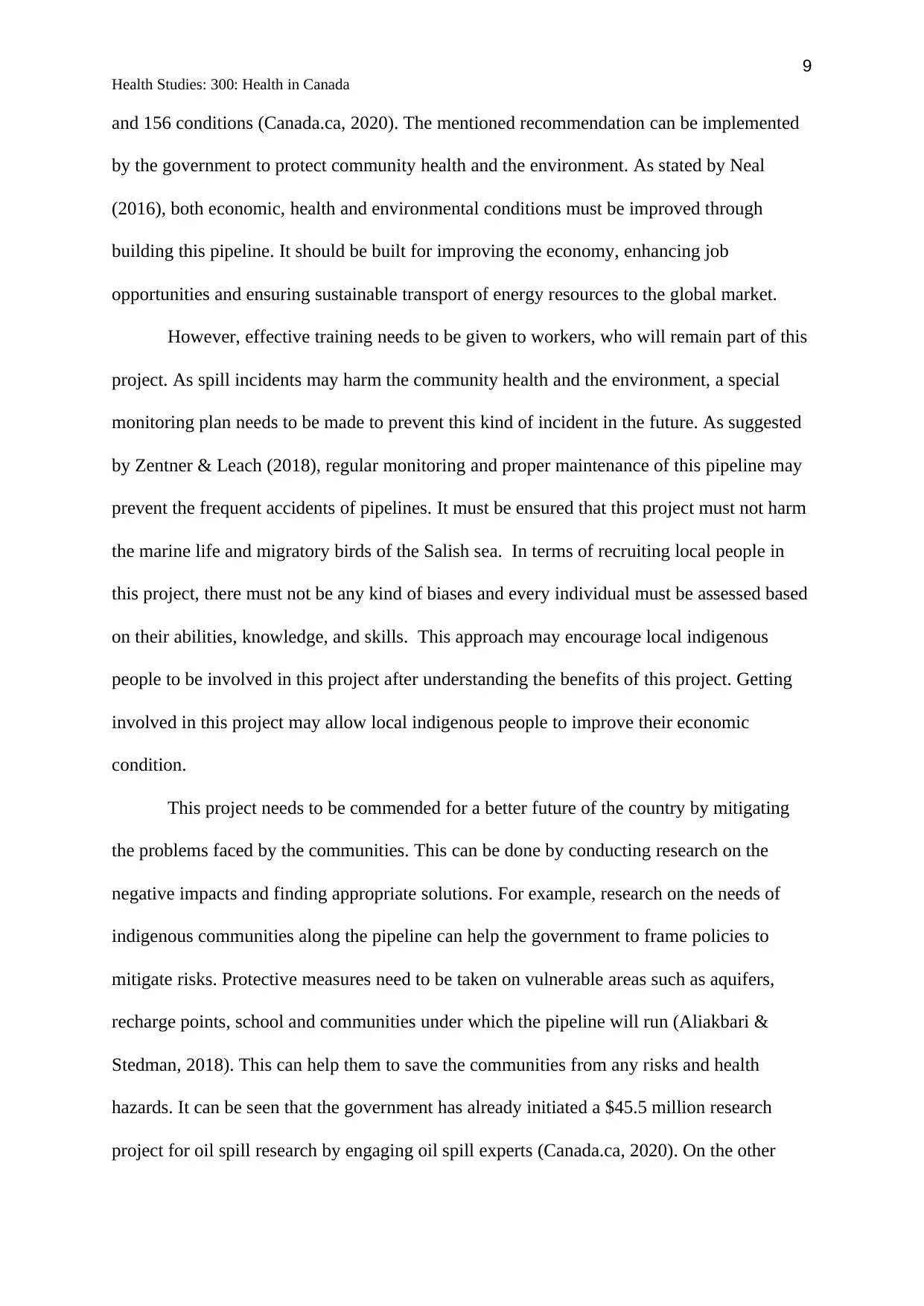
9
Health Studies: 300: Health in Canada
and 156 conditions (Canada.ca, 2020). The mentioned recommendation can be implemented
by the government to protect community health and the environment. As stated by Neal
(2016), both economic, health and environmental conditions must be improved through
building this pipeline. It should be built for improving the economy, enhancing job
opportunities and ensuring sustainable transport of energy resources to the global market.
However, effective training needs to be given to workers, who will remain part of this
project. As spill incidents may harm the community health and the environment, a special
monitoring plan needs to be made to prevent this kind of incident in the future. As suggested
by Zentner & Leach (2018), regular monitoring and proper maintenance of this pipeline may
prevent the frequent accidents of pipelines. It must be ensured that this project must not harm
the marine life and migratory birds of the Salish sea. In terms of recruiting local people in
this project, there must not be any kind of biases and every individual must be assessed based
on their abilities, knowledge, and skills. This approach may encourage local indigenous
people to be involved in this project after understanding the benefits of this project. Getting
involved in this project may allow local indigenous people to improve their economic
condition.
This project needs to be commended for a better future of the country by mitigating
the problems faced by the communities. This can be done by conducting research on the
negative impacts and finding appropriate solutions. For example, research on the needs of
indigenous communities along the pipeline can help the government to frame policies to
mitigate risks. Protective measures need to be taken on vulnerable areas such as aquifers,
recharge points, school and communities under which the pipeline will run (Aliakbari &
Stedman, 2018). This can help them to save the communities from any risks and health
hazards. It can be seen that the government has already initiated a $45.5 million research
project for oil spill research by engaging oil spill experts (Canada.ca, 2020). On the other
Health Studies: 300: Health in Canada
and 156 conditions (Canada.ca, 2020). The mentioned recommendation can be implemented
by the government to protect community health and the environment. As stated by Neal
(2016), both economic, health and environmental conditions must be improved through
building this pipeline. It should be built for improving the economy, enhancing job
opportunities and ensuring sustainable transport of energy resources to the global market.
However, effective training needs to be given to workers, who will remain part of this
project. As spill incidents may harm the community health and the environment, a special
monitoring plan needs to be made to prevent this kind of incident in the future. As suggested
by Zentner & Leach (2018), regular monitoring and proper maintenance of this pipeline may
prevent the frequent accidents of pipelines. It must be ensured that this project must not harm
the marine life and migratory birds of the Salish sea. In terms of recruiting local people in
this project, there must not be any kind of biases and every individual must be assessed based
on their abilities, knowledge, and skills. This approach may encourage local indigenous
people to be involved in this project after understanding the benefits of this project. Getting
involved in this project may allow local indigenous people to improve their economic
condition.
This project needs to be commended for a better future of the country by mitigating
the problems faced by the communities. This can be done by conducting research on the
negative impacts and finding appropriate solutions. For example, research on the needs of
indigenous communities along the pipeline can help the government to frame policies to
mitigate risks. Protective measures need to be taken on vulnerable areas such as aquifers,
recharge points, school and communities under which the pipeline will run (Aliakbari &
Stedman, 2018). This can help them to save the communities from any risks and health
hazards. It can be seen that the government has already initiated a $45.5 million research
project for oil spill research by engaging oil spill experts (Canada.ca, 2020). On the other
⊘ This is a preview!⊘
Do you want full access?
Subscribe today to unlock all pages.

Trusted by 1+ million students worldwide
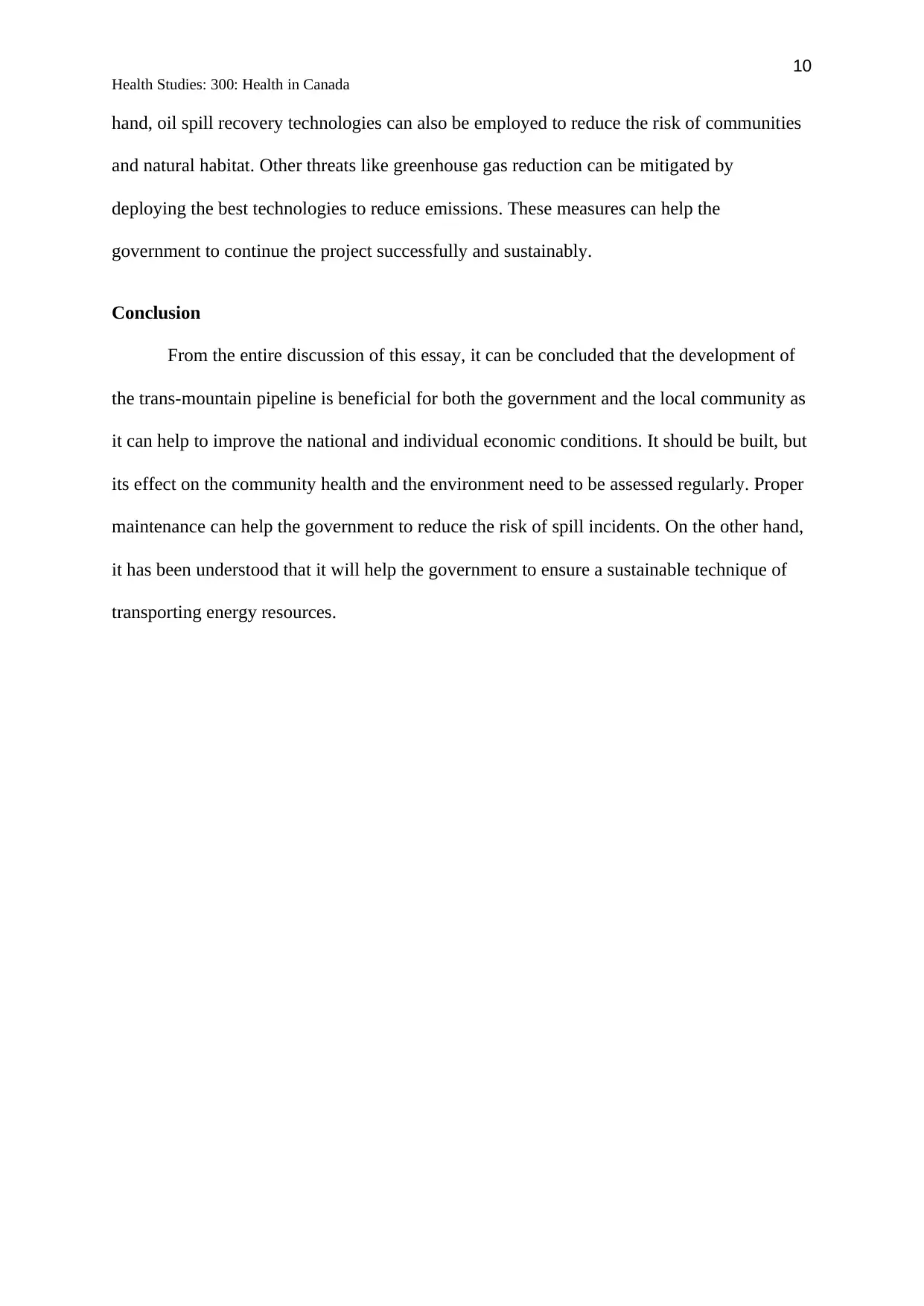
10
Health Studies: 300: Health in Canada
hand, oil spill recovery technologies can also be employed to reduce the risk of communities
and natural habitat. Other threats like greenhouse gas reduction can be mitigated by
deploying the best technologies to reduce emissions. These measures can help the
government to continue the project successfully and sustainably.
Conclusion
From the entire discussion of this essay, it can be concluded that the development of
the trans-mountain pipeline is beneficial for both the government and the local community as
it can help to improve the national and individual economic conditions. It should be built, but
its effect on the community health and the environment need to be assessed regularly. Proper
maintenance can help the government to reduce the risk of spill incidents. On the other hand,
it has been understood that it will help the government to ensure a sustainable technique of
transporting energy resources.
Health Studies: 300: Health in Canada
hand, oil spill recovery technologies can also be employed to reduce the risk of communities
and natural habitat. Other threats like greenhouse gas reduction can be mitigated by
deploying the best technologies to reduce emissions. These measures can help the
government to continue the project successfully and sustainably.
Conclusion
From the entire discussion of this essay, it can be concluded that the development of
the trans-mountain pipeline is beneficial for both the government and the local community as
it can help to improve the national and individual economic conditions. It should be built, but
its effect on the community health and the environment need to be assessed regularly. Proper
maintenance can help the government to reduce the risk of spill incidents. On the other hand,
it has been understood that it will help the government to ensure a sustainable technique of
transporting energy resources.
Paraphrase This Document
Need a fresh take? Get an instant paraphrase of this document with our AI Paraphraser
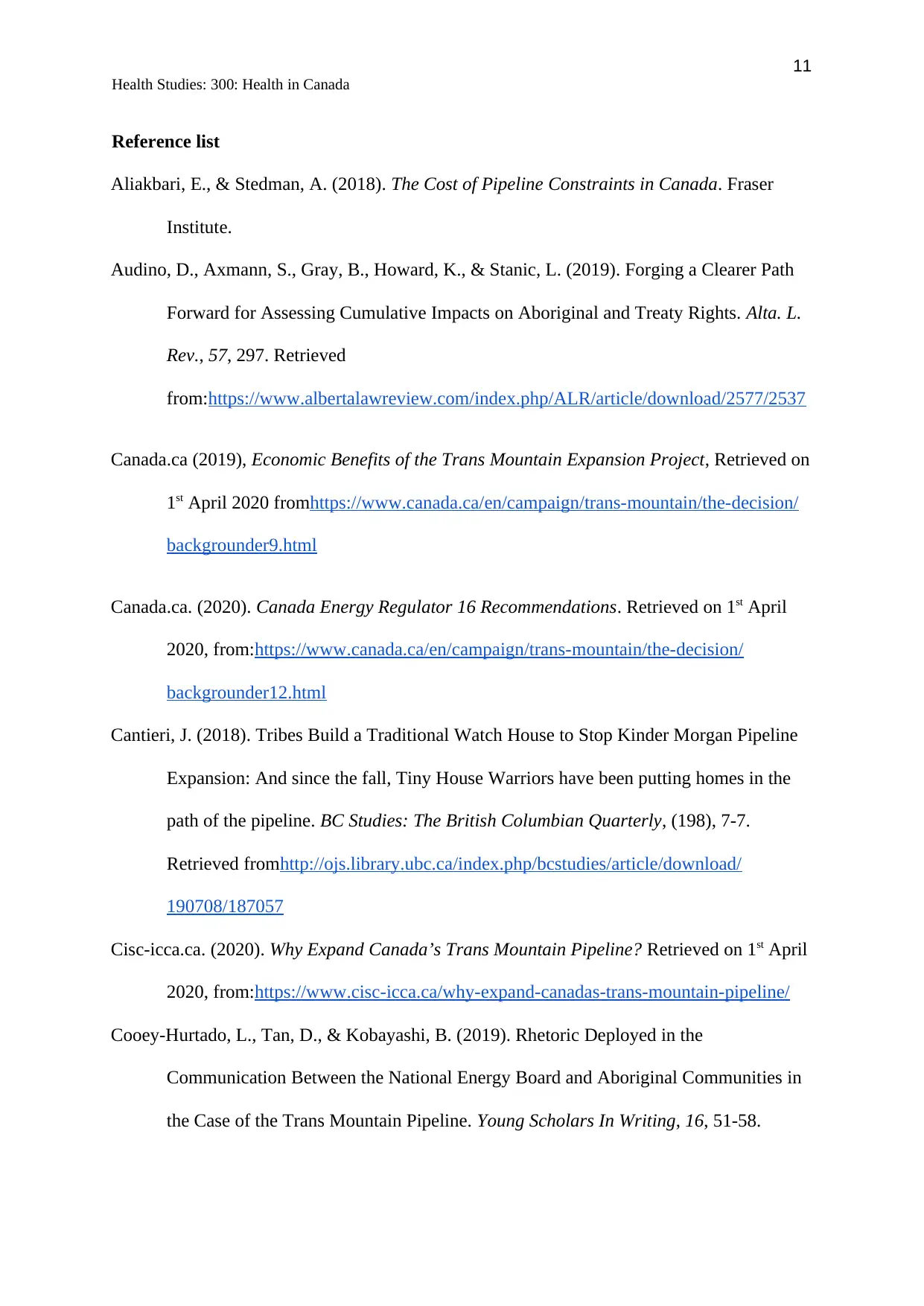
11
Health Studies: 300: Health in Canada
Reference list
Aliakbari, E., & Stedman, A. (2018). The Cost of Pipeline Constraints in Canada. Fraser
Institute.
Audino, D., Axmann, S., Gray, B., Howard, K., & Stanic, L. (2019). Forging a Clearer Path
Forward for Assessing Cumulative Impacts on Aboriginal and Treaty Rights. Alta. L.
Rev., 57, 297. Retrieved
from:https://www.albertalawreview.com/index.php/ALR/article/download/2577/2537
Canada.ca (2019), Economic Benefits of the Trans Mountain Expansion Project, Retrieved on
1st April 2020 fromhttps://www.canada.ca/en/campaign/trans-mountain/the-decision/
backgrounder9.html
Canada.ca. (2020). Canada Energy Regulator 16 Recommendations. Retrieved on 1st April
2020, from:https://www.canada.ca/en/campaign/trans-mountain/the-decision/
backgrounder12.html
Cantieri, J. (2018). Tribes Build a Traditional Watch House to Stop Kinder Morgan Pipeline
Expansion: And since the fall, Tiny House Warriors have been putting homes in the
path of the pipeline. BC Studies: The British Columbian Quarterly, (198), 7-7.
Retrieved fromhttp://ojs.library.ubc.ca/index.php/bcstudies/article/download/
190708/187057
Cisc-icca.ca. (2020). Why Expand Canada’s Trans Mountain Pipeline? Retrieved on 1st April
2020, from:https://www.cisc-icca.ca/why-expand-canadas-trans-mountain-pipeline/
Cooey-Hurtado, L., Tan, D., & Kobayashi, B. (2019). Rhetoric Deployed in the
Communication Between the National Energy Board and Aboriginal Communities in
the Case of the Trans Mountain Pipeline. Young Scholars In Writing, 16, 51-58.
Health Studies: 300: Health in Canada
Reference list
Aliakbari, E., & Stedman, A. (2018). The Cost of Pipeline Constraints in Canada. Fraser
Institute.
Audino, D., Axmann, S., Gray, B., Howard, K., & Stanic, L. (2019). Forging a Clearer Path
Forward for Assessing Cumulative Impacts on Aboriginal and Treaty Rights. Alta. L.
Rev., 57, 297. Retrieved
from:https://www.albertalawreview.com/index.php/ALR/article/download/2577/2537
Canada.ca (2019), Economic Benefits of the Trans Mountain Expansion Project, Retrieved on
1st April 2020 fromhttps://www.canada.ca/en/campaign/trans-mountain/the-decision/
backgrounder9.html
Canada.ca. (2020). Canada Energy Regulator 16 Recommendations. Retrieved on 1st April
2020, from:https://www.canada.ca/en/campaign/trans-mountain/the-decision/
backgrounder12.html
Cantieri, J. (2018). Tribes Build a Traditional Watch House to Stop Kinder Morgan Pipeline
Expansion: And since the fall, Tiny House Warriors have been putting homes in the
path of the pipeline. BC Studies: The British Columbian Quarterly, (198), 7-7.
Retrieved fromhttp://ojs.library.ubc.ca/index.php/bcstudies/article/download/
190708/187057
Cisc-icca.ca. (2020). Why Expand Canada’s Trans Mountain Pipeline? Retrieved on 1st April
2020, from:https://www.cisc-icca.ca/why-expand-canadas-trans-mountain-pipeline/
Cooey-Hurtado, L., Tan, D., & Kobayashi, B. (2019). Rhetoric Deployed in the
Communication Between the National Energy Board and Aboriginal Communities in
the Case of the Trans Mountain Pipeline. Young Scholars In Writing, 16, 51-58.
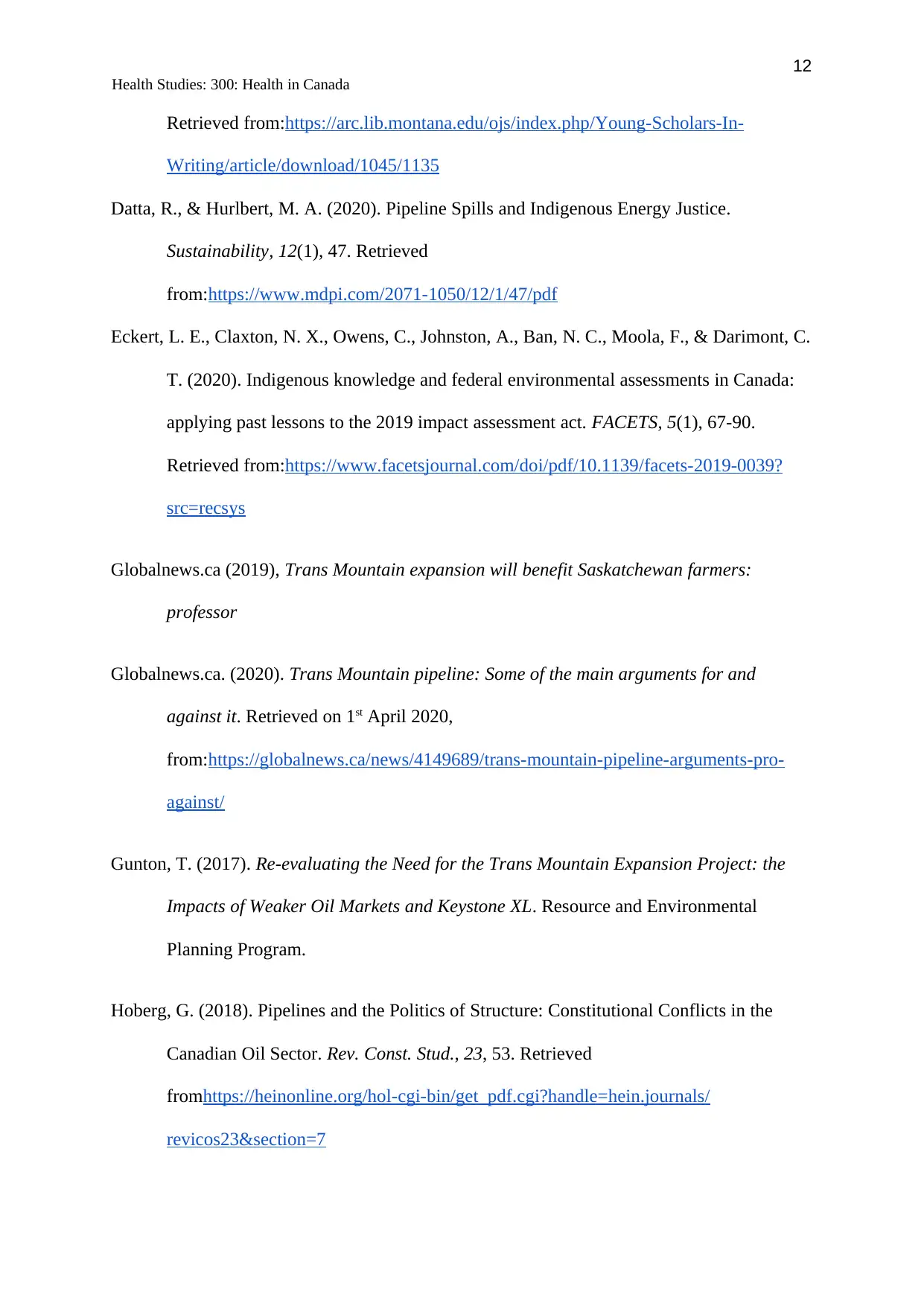
12
Health Studies: 300: Health in Canada
Retrieved from:https://arc.lib.montana.edu/ojs/index.php/Young-Scholars-In-
Writing/article/download/1045/1135
Datta, R., & Hurlbert, M. A. (2020). Pipeline Spills and Indigenous Energy Justice.
Sustainability, 12(1), 47. Retrieved
from:https://www.mdpi.com/2071-1050/12/1/47/pdf
Eckert, L. E., Claxton, N. X., Owens, C., Johnston, A., Ban, N. C., Moola, F., & Darimont, C.
T. (2020). Indigenous knowledge and federal environmental assessments in Canada:
applying past lessons to the 2019 impact assessment act. FACETS, 5(1), 67-90.
Retrieved from:https://www.facetsjournal.com/doi/pdf/10.1139/facets-2019-0039?
src=recsys
Globalnews.ca (2019), Trans Mountain expansion will benefit Saskatchewan farmers:
professor
Globalnews.ca. (2020). Trans Mountain pipeline: Some of the main arguments for and
against it. Retrieved on 1st April 2020,
from:https://globalnews.ca/news/4149689/trans-mountain-pipeline-arguments-pro-
against/
Gunton, T. (2017). Re-evaluating the Need for the Trans Mountain Expansion Project: the
Impacts of Weaker Oil Markets and Keystone XL. Resource and Environmental
Planning Program.
Hoberg, G. (2018). Pipelines and the Politics of Structure: Constitutional Conflicts in the
Canadian Oil Sector. Rev. Const. Stud., 23, 53. Retrieved
fromhttps://heinonline.org/hol-cgi-bin/get_pdf.cgi?handle=hein.journals/
revicos23§ion=7
Health Studies: 300: Health in Canada
Retrieved from:https://arc.lib.montana.edu/ojs/index.php/Young-Scholars-In-
Writing/article/download/1045/1135
Datta, R., & Hurlbert, M. A. (2020). Pipeline Spills and Indigenous Energy Justice.
Sustainability, 12(1), 47. Retrieved
from:https://www.mdpi.com/2071-1050/12/1/47/pdf
Eckert, L. E., Claxton, N. X., Owens, C., Johnston, A., Ban, N. C., Moola, F., & Darimont, C.
T. (2020). Indigenous knowledge and federal environmental assessments in Canada:
applying past lessons to the 2019 impact assessment act. FACETS, 5(1), 67-90.
Retrieved from:https://www.facetsjournal.com/doi/pdf/10.1139/facets-2019-0039?
src=recsys
Globalnews.ca (2019), Trans Mountain expansion will benefit Saskatchewan farmers:
professor
Globalnews.ca. (2020). Trans Mountain pipeline: Some of the main arguments for and
against it. Retrieved on 1st April 2020,
from:https://globalnews.ca/news/4149689/trans-mountain-pipeline-arguments-pro-
against/
Gunton, T. (2017). Re-evaluating the Need for the Trans Mountain Expansion Project: the
Impacts of Weaker Oil Markets and Keystone XL. Resource and Environmental
Planning Program.
Hoberg, G. (2018). Pipelines and the Politics of Structure: Constitutional Conflicts in the
Canadian Oil Sector. Rev. Const. Stud., 23, 53. Retrieved
fromhttps://heinonline.org/hol-cgi-bin/get_pdf.cgi?handle=hein.journals/
revicos23§ion=7
⊘ This is a preview!⊘
Do you want full access?
Subscribe today to unlock all pages.

Trusted by 1+ million students worldwide
1 out of 14
Related Documents
Your All-in-One AI-Powered Toolkit for Academic Success.
+13062052269
info@desklib.com
Available 24*7 on WhatsApp / Email
![[object Object]](/_next/static/media/star-bottom.7253800d.svg)
Unlock your academic potential
Copyright © 2020–2025 A2Z Services. All Rights Reserved. Developed and managed by ZUCOL.



